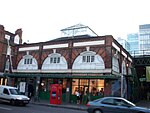Spitalfields Market
Spitalfields

Spitalfields Market is a traders' market as well as a food and art market located in Spitalfields, Central London. Traders began operating around 1666, after the Great Fire of London, where the market stands today. The Spitalfields regeneration programme that ended in 2005, resulted in two new public spaces – Bishops Square and Crispin Place, which restored several historic streets and resulted in more independent retailers and restaurants. Spitalfields Market is situated in the London Borough of Tower Hamlets. It is surrounded by Lamb Street, Old Spitalfields market, Brushfield Street and Bishops Square.
Excerpt from the Wikipedia article Spitalfields Market (License: CC BY-SA 3.0, Authors, Images).Spitalfields Market
Lamb Street, London Whitechapel
Geographical coordinates (GPS) Address Nearby Places Show on map
Geographical coordinates (GPS)
| Latitude | Longitude |
|---|---|
| N 51.519666666667 ° | E -0.076083333333333 ° |
Address
Spitalfields Market
Lamb Street
E1 6DX London, Whitechapel
England, United Kingdom
Open on Google Maps











